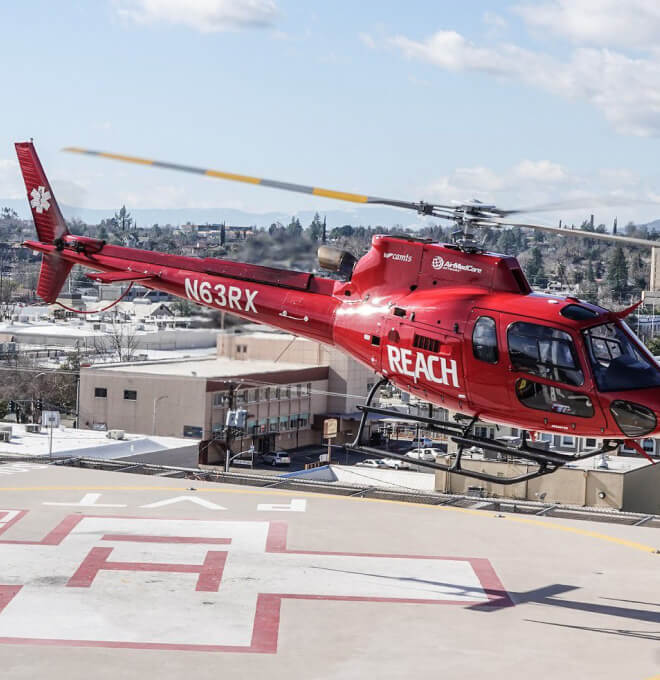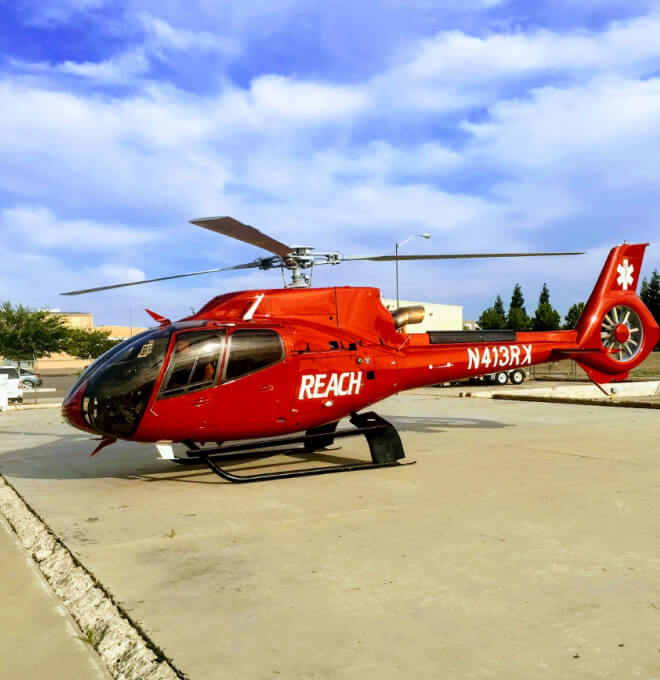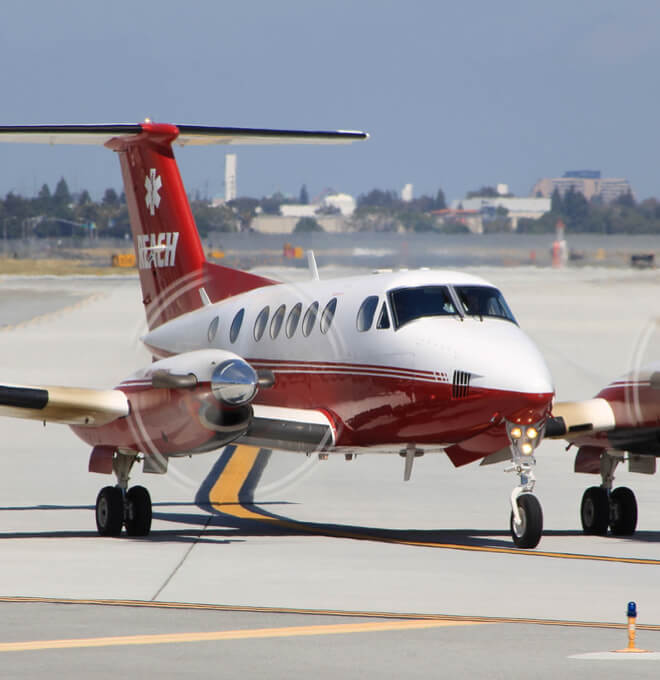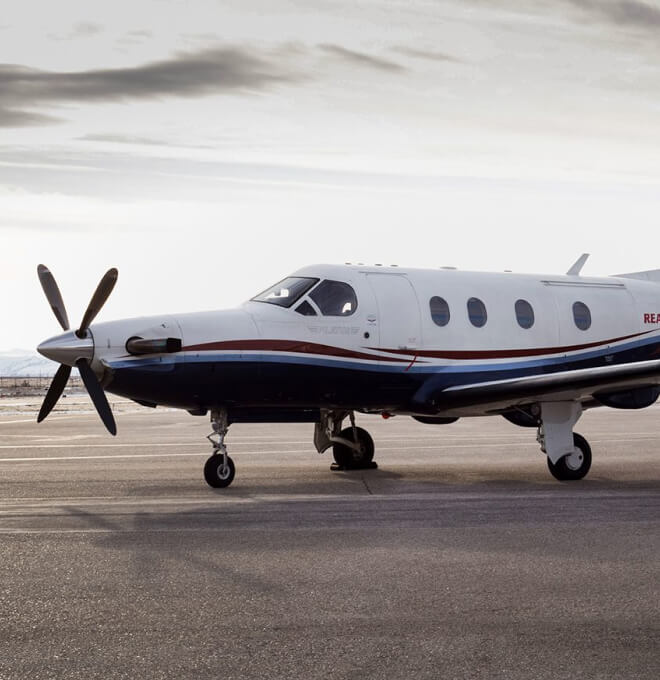
Our Fleet
REACH has an ever-growing state-of-the-art fleet of air ambulances. Innovative thinking keeps REACH at the forefront of flight technology, ensuring our patients and the communities we serve continually receive the best care available. Our highly skilled aircraft maintenance technicians ensure each aircraft is maintained at or above FAA standards to ensure the safety of our patients and crews.

H135
The light twin, multi-mission EMS H135, showcases tomorrow’s technology for today’s demanding EMS mission profile. The H135 features the FADEC system (Full Authority Digital Engine Control) for the state-of-the-art power management. From startup to shutdown, the FADEC system provides optimized performance, safety and fuel efficiency. The H135’s aerodynamic fuselage, constructed from the latest composite technologies, contributes to its excellent speed and range. The unique bearingless main rotor and innovative low noise fenestron tail rotor system offers outstanding maneuverability as well as an exceptionally smooth and quiet ride.
This new generation of light-twin EMS helicopters was developed in close cooperation with doctors, rescue experts, designers and engineers and in compliance with the strictest guidelines. The H135 demonstrates its high standard and flexibility for the air medical industry, and includes dual patient transport capabilities. Considered the most versatile light twin in the HEMS industry today, this rear loading platform through spacious clam shell door design allows for patients of all ages, sizes and acuities.

H125
The H125 helicopter, also known as the AStar AS350, is a single-engine aircraft with stellar performance. It’s an American made machine with enhanced maneuverability and performance. It provides exceptional visibility and can maintain its performance from sea level all the way up to 9,000 feet. Its average cruising speed is 135 mph and has a maximum range of about 345 miles.
The H125 is perfect for air medical transports because of the low vibration levels in the cabin and its four-passenger capacity.

H130
The H130 helicopter strikes the perfect balance between performance, reliability and mission flexibility. Ideal for air medical missions, this single-engine aircraft offers:
- an active Vibration Control System
- advanced environmental controls
- exceptional visibility
- the integration of a crash-resistant fuel system

Beechcraft King Air B200
Speed, comfort, and versatility are especially critical when there are lives at stake. The King Air’s large, pressurized, environmentally controlled cabin facilitates optimal patient care during transport. This aircraft provides fast long-distance transports for critical-care patients.
The King Air is capable of instrument flight during less-than-ideal weather conditions. With speeds up to 310 mph and a range of approximately 900 miles round trip, the time-tested B200 aircraft has proven reliability to facilitate rapid transports when the need arises.

Pilatus PC12-45
The Pilatus PC12-45 airplane is a single-engine turboprop passenger aircraft and it is perfect for air medical transports. It has a maximum speed of just over 300 mph and a range of about 2,500 miles. This airframe boasts a spacious cabin that holds two patients and the attending clinical crew.
With fantastic visibility and versatility, this aircraft is capable of operating in even the most rugged environments.
Innovation & Excellence
- The REACH rotor-wing fleet includes the twin-engine IFR-capable H-135 aircraft, as well as the single-engine H-125 and H-130. These aircraft have a cruise speed of approximately 120-160 mph. Our fleet also includes single-engine, VFR-only Bell 407 aircraft.
- REACH operates King Air B200 twin-engine IFR-capable pressurized fixed-wing aircraft, as well as the Pilatus PC-12. The cruising speeds of these aircraft are 290-300 mph.
- REACH operates under its own FAA part 135 Air Carrier Certificate.
- REACH takes pride in providing state-of-the-science service to the communities it serves, using the most advanced equipment to facilitate the safe transport of patients in critical flight situations. An essential element of REACH’s success is our ability to respond to flight requests for transport, in most instances, despite inclement weather. We can skillfully respond to most situations because of our IFR capability, allowing us to safely respond in adverse weather conditions.
- Our development of GPS routing increases our ability to respond to emergencies in a variety of conditions. We were the first air ambulance company in the United States to receive approval by the FAA to respond off airway, using our own GPS routes to specific hospitals. This innovative technology has reduced transport time to multiple hospitals throughout Northern California.
- The NTSB (National Transportation Safety Board) and the FAA view night vision goggles (NVGs) as one way of enhancing safety for night operations. Night vision goggles take any available ambient light, such as the moon and stars, and multiply it thousands of times, turning darkness into “near daylight” conditions. Historically, night vision goggles were only utilized by the military. Recently, this technology has been transferred to the private aviation sector. REACH is in the forefront of the private EMS aircraft operators having become only the fifth program in the nation to fully implement NVG technology. REACH has performed missions utilizing NVG technology since February of 2004.
Peace of Mind
REACH’s team of FAA-licensed Airframe and Powerplant (A&P) mechanics ensure our fleet is maintained to the highest standards. REACH’s A&P mechanics have taken great strides in customizing the aircraft cockpits and patient care cabins to better suit the needs and safety requirements of both patients and crew during critical care transports. We provide state-of-the-science service to facilitate the safe and efficient transfer of patients in critical situations.
REACH’s team of FAA-licensed A&P mechanics provide unmatched aviation support and services for aircraft at all bases, 24 hours a day, to ensure the continued airworthiness, reliability and safety of our fleet. Each base has a full-time dedicated mechanic.
